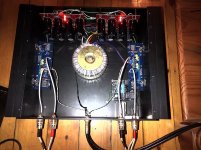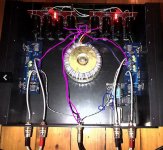Check your input wiring. If you biased the output ok, then you have some resistance in series with the drains of Q1 & Q2 - do you have a signal at the drain of Q1 & Q2? Ok, it will be small and not necessaraly equal.I biased both channels nicely as described 0.6V over the .47R and output dc offset to less than 10mV on both channels. I then went and connected source and speakers and the one channel is dead
There are only 4 active devices.
All 4 work in controlling the output bias current and in turn controlling the output offset.
As far as I know all 4 must be working to at least some performance to achieve both output bias and output offset.
As far as I can see/understand the no output signal has to be before the gates to the jFETs.
i.e. an input error.
Swap channels at the outputs terminals,
Swap channels at the input terminals.
Swap channels at the Source.
All 4 work in controlling the output bias current and in turn controlling the output offset.
As far as I know all 4 must be working to at least some performance to achieve both output bias and output offset.
As far as I can see/understand the no output signal has to be before the gates to the jFETs.
i.e. an input error.
Swap channels at the outputs terminals,
Swap channels at the input terminals.
Swap channels at the Source.
As far as I know all 4 must be working to at least some performance to achieve both output bias and output offset.
Output bias can still be achieved with short circuit JFET's.
Valvesound,
Hopefully you have found the problem, if you haven't, check the voltage at the drains of Q1 & Q2 with a meter, with a fully biased output and working JFET's, it should be between 3 & 4.5 volts lower than the supply rail(s).
Note, N & P FET devices require different bias voltages so don't expect them to be the same.
I'm not sure about this. Are you sure you are right?Output bias can still be achieved with short circuit JFET's...........
Short out one or both jFETs and the currents in the resistors will allow output bias and output offset to be set up properly?
I can't see it.
That shorting of both jFETs to mainatin symetry will pull both output gates to the same voltage.
That will put supply rail voltage across the two sets of GS resistors.
If both VR are @ zero ohms then the input burns up the traces due to tens/hundreds of amperes flowing.
If one jFET is shorted then the other will have to take double the Vds and I'm not sure what happens when one tries to set up the bias and the offset by adjusting the VRs from their zero r point.
That shorting of both jFETs to mainatin symetry will pull both output gates to the same voltage.
That will put supply rail voltage across the two sets of GS resistors.
If both VR are @ zero ohms then the input burns up the traces due to tens/hundreds of amperes flowing.
If one jFET is shorted then the other will have to take double the Vds and I'm not sure what happens when one tries to set up the bias and the offset by adjusting the VRs from their zero r point.
If both VR are @ zero ohms then the input burns up the traces due to tens/hundreds of amperes flowing.
The 10 ohm source resistors would limit the maximum current to 2.4A, if there is one turn on the ten turn pot from short circuit, the current would be aprox 100mA
24v/(5K/10)//(2k2+~4k7)=~0.1A
The amp is still burning-in but overall I am very happy with the F5.
A quick comparison F5 25W class A to JLH 25W class A is:
There is an overall improvement with the F5 but subtle, not night and day.... yet, there has been improvement from Friday evening to last night.
Bass is less than JLH but not lean in any way.
Female vocals are superb with more texture.
The music sounds higher in definition (like comparing full 1080p Blue ray to upscaled DVD)
The JLH is a great amp but took a lot of tweaking with boutique components to sound as it did, where the F5 was great as is "out the box".
A quick comparison F5 25W class A to JLH 25W class A is:
There is an overall improvement with the F5 but subtle, not night and day.... yet, there has been improvement from Friday evening to last night.
Bass is less than JLH but not lean in any way.
Female vocals are superb with more texture.
The music sounds higher in definition (like comparing full 1080p Blue ray to upscaled DVD)
The JLH is a great amp but took a lot of tweaking with boutique components to sound as it did, where the F5 was great as is "out the box".
Attachments
Nice to see you got it running!
I would move the IEC input and softstart to the middle of the back panel and the inputs somewhere above or below the respective speaker binding posts.
Yes something I'll do next time round. I do not have any interference or hum so not required but something I would do differently in future. Thanks
Guys, i recently moved overseas, and where my f5 has been built and biased on 230vac, my new home has 220v (at least according to spec, haven't measured actual yet as my stuff is still on its way on a container vessel).
Given the psu is unregulated, what can i expect when i turn the amp on?
Given the psu is unregulated, what can i expect when i turn the amp on?
F5 grounding
Look at the picture attached. The purple lines indicate the 0V star point. It is very important. connect both supply 0V points to the star point. From the star point all 0V connections run to individual channels. From the star point run wires to RCA inputs 0V (RCA's are isolated from chassis). keep wire lengths for left and right channels equal length. The only ground (earth) connection is indicated by blue. The mains earth is connected to the chassis there. On the power supply I have a 10ohm connecting chassis earth to the 0V point.
If you do exactly this, you will have a dead dead quiet F5 amplifier.
Look at the picture attached. The purple lines indicate the 0V star point. It is very important. connect both supply 0V points to the star point. From the star point all 0V connections run to individual channels. From the star point run wires to RCA inputs 0V (RCA's are isolated from chassis). keep wire lengths for left and right channels equal length. The only ground (earth) connection is indicated by blue. The mains earth is connected to the chassis there. On the power supply I have a 10ohm connecting chassis earth to the 0V point.
If you do exactly this, you will have a dead dead quiet F5 amplifier.
Attachments
Guys, i recently moved overseas, and where my f5 has been built and biased on 230vac, my new home has 220v (at least according to spec, haven't measured actual yet as my stuff is still on its way on a container vessel).
Given the psu is unregulated, what can i expect when i turn the amp on?
Just less overhead. And by the way, the transformer will be cooler (less saturation). The bias will remain (almost) the same. But you will normally never hit the power rail, and the F5 intrinsically has soft-clipping anyway.
- Home
- Amplifiers
- Pass Labs
- F5 power amplifier

